Key takeaways:
- Diversification and personal connection to investment sectors have proven essential for a more balanced and meaningful investment strategy.
- Conducting thorough market research, including understanding market size and competitive landscape, significantly influences informed investment decisions.
- Learning from both successful and unsuccessful investments shapes future approaches, emphasizing the value of flexibility, team dynamics, and celebrating small victories.

Understanding Startup Investment Strategies
Understanding startup investment strategies is crucial for anyone looking to dive into this dynamic landscape. One strategy I found particularly effective is diversifying my portfolio. Early on, I had a tendency to put all my eggs in one basket, which felt thrilling but ultimately risky. Once I embraced a more balanced approach, I felt more secure knowing that if one investment didn’t pan out, others might still thrive.
Another path I explored was investing in sectors I was passionate about, like tech and sustainability. This wasn’t just about financial gain; it was deeply personal. I remember when I backed a small renewable energy startup. Their mission resonated with my values, and watching them grow reminded me that investing isn’t just numbers—it’s about fueling innovation that aligns with my beliefs.
I also learned the importance of networking. At a startup pitch event, I connected with founders who shared their stories—some were heartwarming, others sobering. Hearing their journeys made me realize that understanding the people behind the business is vital. How can you invest in something without truly knowing its heart? I’ve discovered that a strong connection with founders often leads me to make more informed and confident investment decisions.
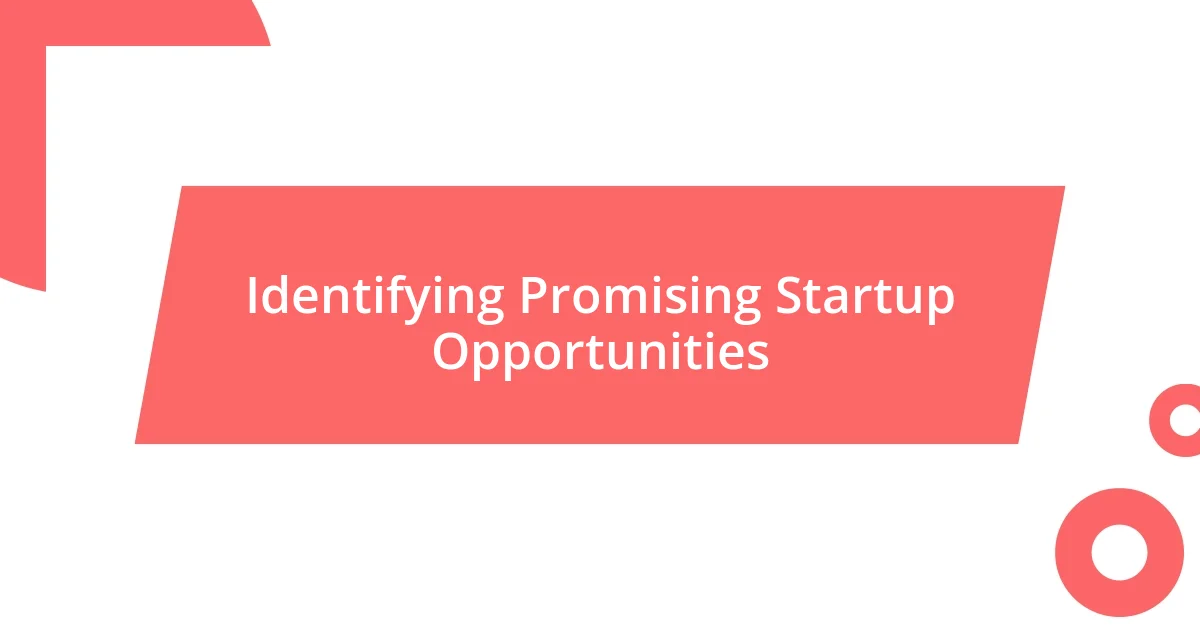
Identifying Promising Startup Opportunities
Identifying startup opportunities involves a mix of instinct and informed research. I remember attending a tech expo where a few startups stood out not just for their products but for their passionate teams. One team, in particular, shared a compelling vision for their app, and it sparked an excitement in me. It wasn’t just about the tech; it was about their drive and commitment that led me to invest. It’s essential to look beyond the product and find that spark in the founders.
When I evaluate potential investments, I keep a few key factors in mind:
- Team Passion: Strong belief in their mission can translate into perseverance and success.
- Market Need: Is there a genuine problem they are solving?
- Unique Value Proposition: What sets them apart from competitors?
- Growth Potential: Is the market growing, and does the startup have the potential to scale?
- Personal Connection: Does the startup resonate with my values or interests?
These criteria help me sift through numerous opportunities, ensuring I invest in startups that not only excite me but also show real promise. Each decision becomes a balancing act of emotion and analysis, making the journey all the more rewarding.

Conducting In-Depth Market Research
Conducting in-depth market research has been one of the most transformative aspects of my investing journey. At first, I noticed I was drawn to flashy pitches and compelling stories. However, diving deeper into the market dynamics became crucial. I recall a time when I overlooked the importance of understanding a target market’s size. A small health tech startup I invested in initially seemed promising, but I later realized their niche wasn’t nearly large enough to sustain growth. This experience taught me that no matter how enthusiastic I feel, it’s essential to evaluate the potential market thoroughly.
I’ve also found value in assessing competitors when conducting market research. During the evaluation of a promising fintech company, I analyzed their rivals and discovered gaps in their offerings. By comparing features and customer feedback, I recognized what the startup could improve upon. This pivotal analysis not only gave me confidence in my investment but also led the founders to rethink their strategies. It’s quite fascinating how understanding the competitive landscape can illuminate opportunities for innovation and growth.
Moreover, part of my research involves engaging with industry trends. I consistently keep an eye on emerging technologies and shifts in consumer preferences that might shape the future. For instance, I remember attending a webinar on artificial intelligence where trends in automation took center stage. Hearing experts discuss how AI would revolutionize various industries made me reconsider my portfolio priorities. My insights from such events often lead to investing in startups that are not just reacting to the present but are poised to leverage future trends.
| Research Component | Importance |
|---|---|
| Market Size Analysis | Understanding whether the market can accommodate growth. |
| Competitive Landscape | Identifying strengths and weaknesses of competitors can highlight opportunities. |
| Industry Trends | Staying informed on trends allows for foresight in potential investments. |
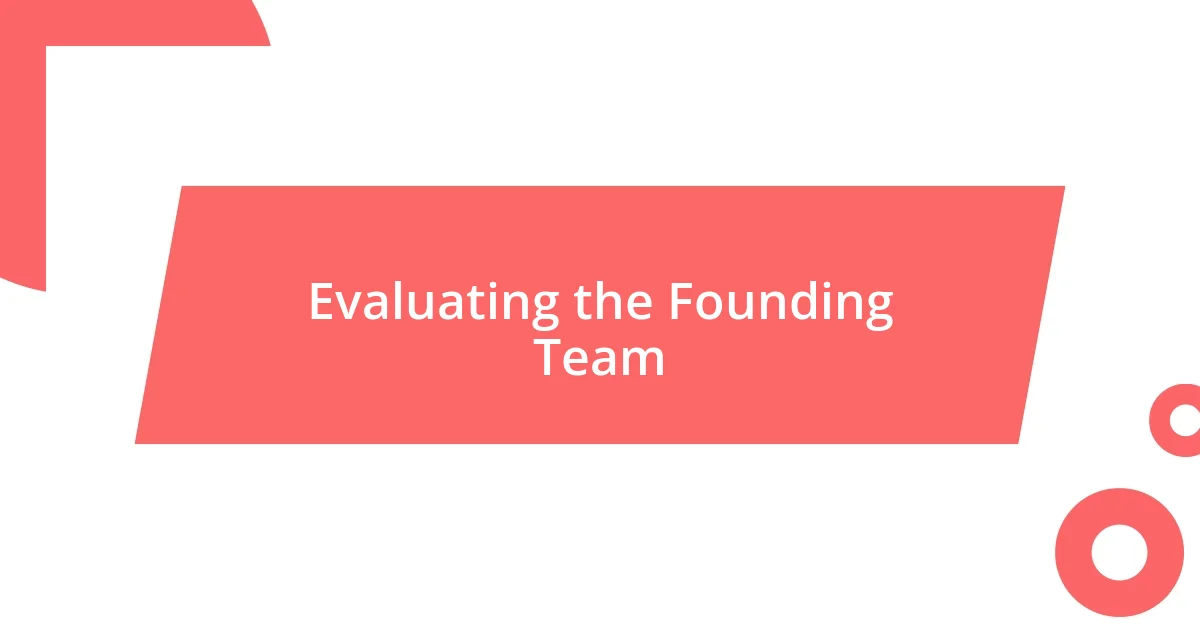
Evaluating the Founding Team
Evaluating the founding team is a critical step I always take before making an investment. I once met a pair of founders whose shared commitment resonated with me; they spent hours discussing their vision over coffee. Their enthusiasm was palpable, and I couldn’t help but feel that their passion would drive the team through tough times. Has there ever been a moment where you’ve felt such genuine belief from someone? It’s these feelings that often dictate my choices.
Beyond passion, I pay close attention to the team’s experience and dynamics. For instance, during a pitch, a founder seamlessly handled a tough question while the other listened intently, showing they were in sync. This was a strong indication to me that they valued collaboration, which I believe is critical for a startup’s resilience. I often wonder how many teams overlook this essential aspect. When personalities mesh well, it can substantially uplift the entire operation.
Lastly, I find it crucial to assess how adaptable the founding team is. In one case, I invested in a startup that pivoted quickly after receiving feedback from early users. The founders didn’t cling to their original idea out of pride; instead, they embraced change wholeheartedly. I admired their willingness to listen and adapt, which made me confident in their ability to navigate challenges ahead. In my experience, it’s not just about the initial idea but how flexible the team is to evolve with the market. How often do we see businesses falter because they couldn’t move with the times?
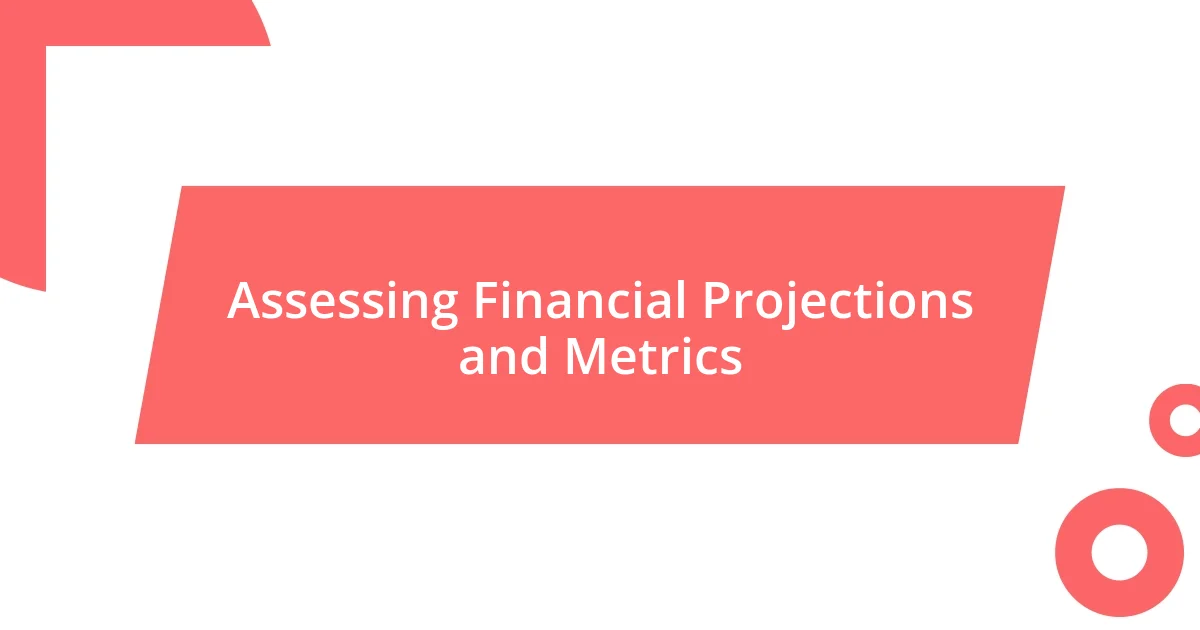
Assessing Financial Projections and Metrics
Assessing financial projections and metrics is a crucial part of my investment strategy. I’ve found that a startup’s projected revenue can often be a chasm between aspiration and reality. In one instance, I invested in a tech startup whose projections seemed overly optimistic; they promised rapid growth based solely on a shiny marketing strategy, but upon digging deeper, I realized their customer acquisition cost was far too high. This experience urged me to measure projections against realistic market expectations and understand the metrics that drive success.
When it comes to key performance indicators (KPIs), I now focus heavily on customer lifetime value (CLV) versus customer acquisition cost (CAC). This ratio had previously eluded me when I got excited about a new app, only to discover later that maintaining customers was becoming increasingly expensive. It’s eye-opening to think about how many startups can boast impressive initial numbers but can struggle with profitability in the long run. Wouldn’t you agree that understanding these metrics is vital for making informed decisions?
I also make it a point to assess recurring revenue models, especially in SaaS businesses. A standout moment for me was when I evaluated a subscription service that exhibited remarkable month-over-month growth. Their strong focus on retaining customers with excellent service immediately caught my eye. This taught me how a stable revenue stream can ease a startup’s path to scaling. I’ve come to realize that in the world of investing, metrics aren’t just numbers; they reflect the pulse of the business. Wouldn’t you say that a clearer understanding of these financial projections helps in making more confident investment choices?
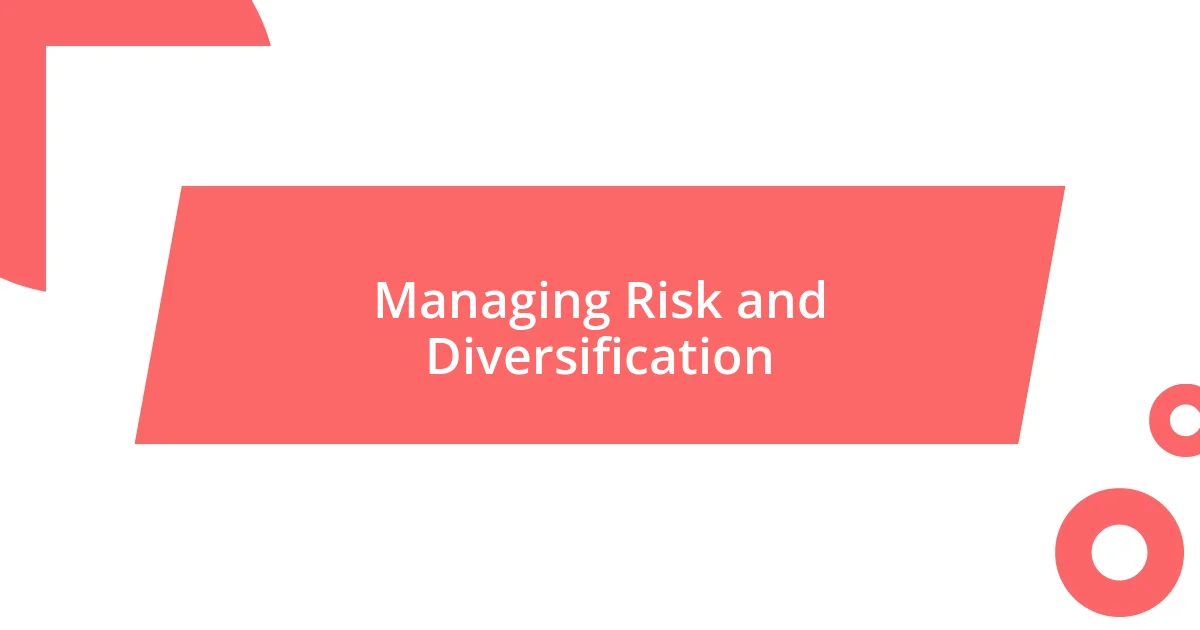
Managing Risk and Diversification
Managing risk and diversification has been a continuous learning journey for me as an investor. Early on, I was eager to put all my resources into one promising startup, convinced it would skyrocket. However, when that venture faced unforeseen setbacks, I realized the importance of spreading my investments. It’s like choosing to plant a garden with a variety of seeds instead of just one. Have you ever put all your chips on a single bet, only to watch it wither away?
As time passed, I developed a strategy of diversifying across different sectors and stages of startups. By investing in both technology and consumer goods, for instance, I mitigated the risk of market fluctuations. When the tech sector took a hit one quarter, my investments in more stable consumer brands helped maintain balance in my portfolio. This taught me that when we look beyond singular opportunities, we create a safety net that cushions against volatility. Isn’t it fascinating how a little variety can lead to more peace of mind?
Additionally, I’ve grown to appreciate cohort investing, where I enhance my portfolio by tracking and investing in groups of startups at similar stages. I remember my excitement while participating in a fund that backed several early-stage biotechnology firms simultaneously. Knowing that I was investing in a group, rather than a single entity, reduced my stress levels significantly. It’s like watching a collection of beautiful, unique paintings rather than focusing on just one masterpiece. How often do we forget that diversifying not only reduces risk but also opens us up to unexpected treasures?
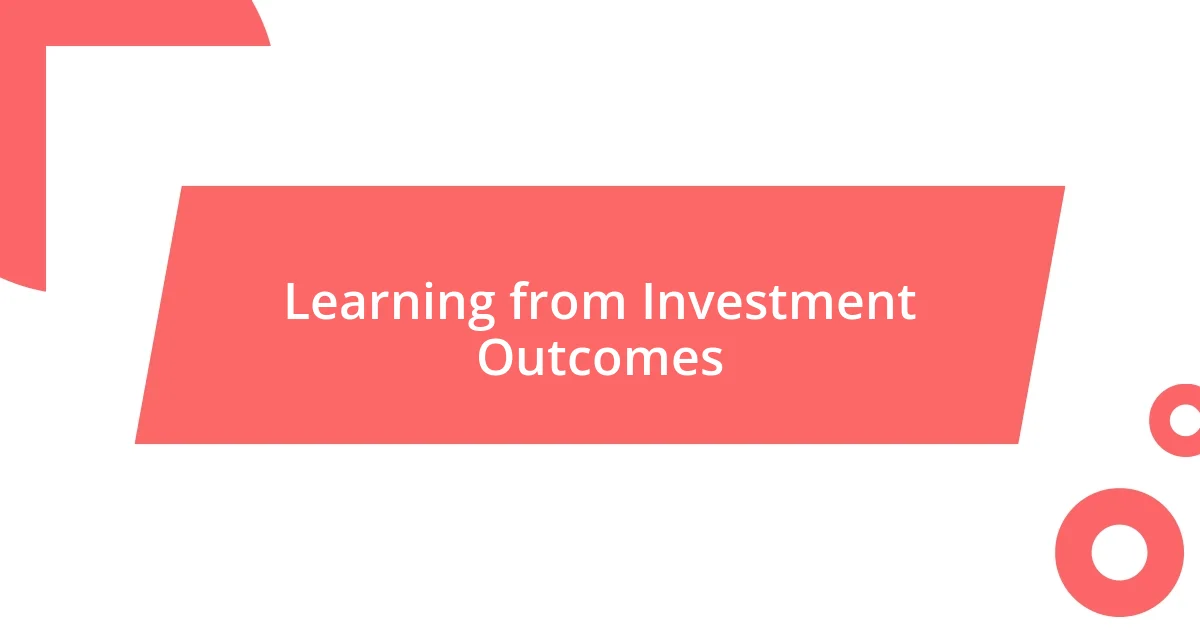
Learning from Investment Outcomes
Learning from investment outcomes is perhaps one of the most enlightening aspects of my journey in startup investing. I vividly recall a situation where I had backed a food delivery startup, only to watch it falter due to inefficiencies in its supply chain. The initial excitement turned to disappointment, but it pushed me to analyze every aspect of the operation. This experience made me realize that outcomes aren’t just numbers on a spreadsheet; they’re lessons in understanding the ecosystems in which these startups operate. Have you ever faced a setback that forced you to reevaluate your approach?
Interestingly, I also learned that even unsuccessful investments can yield valuable insights. After a mobile app I invested in failed to find traction, I sat down with the founders for a candid discussion. Through our debrief, I discovered how crucial market timing can be. This interaction shifted my investment philosophy, making me more insistent on assessing the competitive landscape and timing of the market. It’s these conversations that reveal the nuances that numbers often hide. Isn’t it inspiring how failure sometimes unveils the hidden truths of an industry?
Moreover, reflecting on positive outcomes has taught me the importance of celebrating small victories. I once invested in a fintech startup that surpassed all expectations in its first year. Watching their innovative approach gain traction filled me with pride and reinforced my belief in nurturing supportive relationships with founders. Examining why this investment flourished—like their relentless focus on user feedback—encouraged me to apply similar scrutiny to my other ventures. Wouldn’t you agree that understanding both successes and failures shapes us into better, more informed investors?














